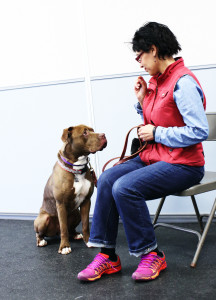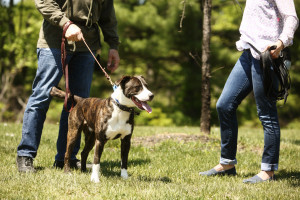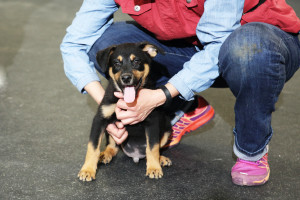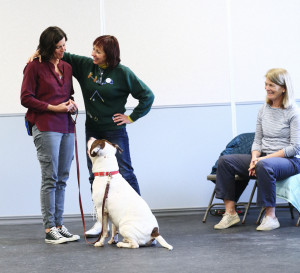Behavior Problem-Solving 101 (continued)

Teaching a dog to “Watch” – give you eye contact – can be useful for many situations, including helping with behavior issues on leash.
Last month we began discussing the art and science of training a dog to change their actions (behavior modification). If you haven’t read the first part of this article yet, or want a review, check it out here. Remember, the three most important concepts for “b-mod” are: Triggers, Management, and Training. We reviewed Triggers and Management in the first part of this article, so today we move ahead into Training.
Training
Training is the most complex part of the behavior modification process. This is because the goal is for the dog to learn new responses to the trigger and often involves changing the dog’s emotional state as well. Success depends on many factors, including how strong the unwanted behavior pattern is, how skilled the trainer is, and how dedicated the owner is. Some behavior change takes a tremendous amount of work and patience (ex., serious separation anxiety or fears due to under-socialization). On the other hand, for many common behavior problems, you can make a lot of progress with a focused period of training over a few weeks. Let’s look at our example behavior issues from part 1 of this article, and this time we’ll add a few ideas for training solutions.
Note: when we mention rewards, we are typically going to use high value food rewards, but play could work well in some scenarios, too. With that in mind, here is each behavior issue now with the triggers, management solutions, and a few (of the many possible) training solutions you could use:
-

If you can get the dog to focus on you instead of the trigger, the solution process has begun.
Unwanted behavior: Barking and lunging at other dogs during a walk
- Trigger: Seeing another dog from 20 feet away or less while on leash
- Management: When walking the dog: avoid places that are busy with other dogs, cross the street or turn in the other direction when you see a dog that will come within 20 feet away (ideally before the trigger distance hits)
- Training: Teach the dog to look at you in order to earn a reward whenever he sees another dog during a leash walk. This does three things: 1) It takes the focus off the other dog, 2) puts the focus/connection on you, 3) begins to add a joyful association with seeing other dogs on walks (to change the emotional state). You can also reward the dog for following you in another direction away from the dog that is triggering the barking and lunging. Eventually, as the dog learns control, you can get gradually closer to other dogs and also reward for things like Sit-Stay in the presence of dogs or just train a Heel right past them!
- Unwanted behavior: Growling and snapping at owner’s friends
- Trigger: Being in the owner’s lap or arms when a person reaches out to pet the dog. Dog triggers when hand gets within 2 feet from their body.
- Management: Don’t pick up the dog or keep her in your lap when your friends come over, ask your friends not to reach out and pet the dog unless she comes over to them first.
- Training: When guests come over, reward the dog for quiet, non-threatening behavior while four paws are on the floor (not in lap, arms, or on furniture). Once that is established, reward the dog for any non-threatening approach towards guests (voluntary by the dog only). Once the dog is comfortably coming near to guests, reward for hand-targeting to guests’ hands. (Hand targeting means the dog touches their nose to the extended hand.) Once all of the above is established with a relaxed dog that is enthusiastically participating, reward for hand targeting guests’ hands while on the owner’s lap. You may need an intermediate step first, such as hand targeting while next to the owner’s feet.
-

So cute, but such trouble!
Unwanted behavior: Urinating on the carpet in the dining room (puppy)
- Triggers: Been indoors for over 2 hours, drank a lot of water after last play session, was not supervised or confined
- Management: Get the pup outside every 2 hours to empty his tank, watch water intake and increase frequency of going out when water intake goes up, do not allow pup to leave your sight or keep in a confined area during the housetraining period
- Training: This one is easy, because urinating and defecating are both self-rewarding. In other words, it automatically feels good to the dog to “empty their tank.” So, as long as you manage the pup in such a way that they always end up in the right place when they urinate or defecate (ex., your yard or sidewalk), then it will feel good for them to go in that spot. When they continually feel good from going to that place several times a day every day, that area and surface will naturally become their preferred place to “go to the bathroom.” You can add praise and food rewards for going in the right spot to further make it clear that this is very different from soiling in the house, which should be seen and interrupted every time.

Even with “good dogs,” sometimes we need consolation and support from our trainer!
As you can see, training is the part that takes the most time and effort. In some cases it can be simple (like housetraining) and in others the process can have many steps that require more knowledge and skill, like the leash reactivity or snapping at guests. The above solutions for those first two issues are quick summaries of processes that would typically be carried out over a series of sessions with the guidance of a behavior expert. Regardless, in all cases, the key is to first learn the triggers and then decide how to manage them.
Be realistic. Due to busy work schedules, family, etc., there are cases where owners (you?) do not have the time, energy, or resources for long or complex training processes. The good news for those homes is that management is still an excellent choice for keeping unwanted behaviors under control. So, if you’re living with behaviors you don’t like, make a list of the triggers and start managing them today to prevent any further troubles!
~
Thanks for joining us for this two-part blog series (part one here). For trainers with a developing interest in behavior modification, we hope this summary gives you a good perspective on the big picture. For dog owners, now that you have a basic understanding of b-mod, seek out experienced trainers who can lead and coach you to success with these processes. Happy training everyone!
~
Find dog behavior fascinating? So do we! Click here to discover what you can learn at CATCH and how you can help dogs and their owners with pro skills of your own.






 Phone:
Phone:
I very much enjoyed reading both articles.
Very helpful in getting the larger picture.
thank you!
Our pleasure, Katerina, thanks for reading!